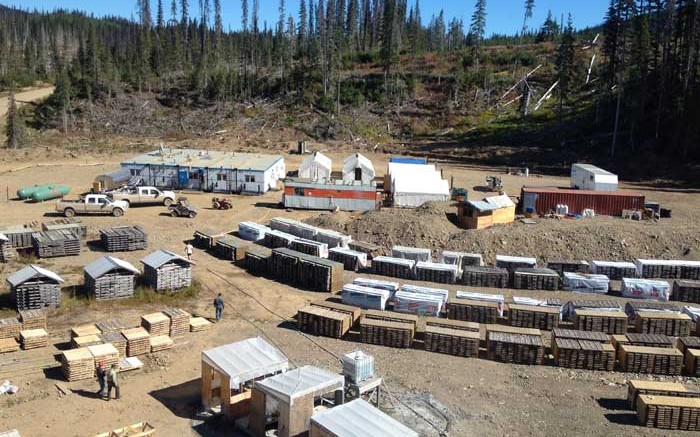VANCOUVER — The first half of 2013 has been a busy time for Gold Reach Resources (TSXV: GRV) at its Ootsa property in B.C. Since January the company has updated the resource estimates for the project’s two deposits, shown that Ootsa’s copper, molybdenum, silver and gold respond well to conventional recovery techniques, and hit into higher-than-expected grades with the first few holes of this year’s drill program.
Ootsa is in northwest B.C., near the town of Houston and adjacent to the operating Huckleberry mine owned by Imperial Metals (TSX: III; US-OTC: IPMLF) and a consortium of Japanese firms. The property’s two deposits, Ox and Seel, are 4 km apart. The Damascus fault that runs between them also hosts a historic silver resource.
Ox and Seel — the latter of which is divided into the East and West zones — are both near-surface porphyry deposits that remain open for expansion. Gold Reach is completing infill and expansion drilling at all three zones this year, with the aim of boosting confidence in Ootsa’s resources and expanding the project’s resource counts before economic studies later this year.
So far, drill results are supporting this goal.
The drill at Ootsa started the season by punching holes in the Ox deposit, and the first seven holes have returned better-than-expected grades. Collared near the south end of the deposit, hole 48 cut 114 metres of 0.28% copper, 0.041% moly and 1 gram silver per tonne, starting 6 metres downhole and including 70 metres of 0.32% copper and 0.061% moly. Nearby, hole 49 returned two intercepts: 21 metres of 0.23% copper and 0.01% moly from surface, followed by 92 metres of 0.28% copper, 0.034% moly and 1.19 grams silver from 40 metres depth.
Those grades are higher than the Ox resource model suggests. In addition, hole 48 and 49 were designed to intersect the Damascus fault, which they did, helping to pinpoint its location. That matters because, while the fault marks the boundary of mineralization in the southern part of Ox, Gold Reach believes that mineralization at the north end of the zone continues east of the Damascus fault under a shallow pond. The company will test the theory later this year.
Nearby, hole 46 did not hit the fault, which meant it returned a lengthy mineralized intercept: 162 metres grading 0.36% copper and 0.028% moly. Hole 47 produced a similar result, cutting into 111 metres grading 0.28% copper and 0.028% moly.
Other results from Ox include 62.5 metres grading 0.34% copper, 0.027% moly and 1.42 grams silver from 12 metres down hole 50; 134.6 metres of 0.28% copper, 0.031% moly and 0.93 gram silver from 8 metres down hole 52; and 113 metres of 0.26% copper, 0.028% moly and 0.81 gram silver from 28 metres down hole 53.
Gold Reach president Shane Ebert says the company is “extremely pleased” with the higher grades they are finding along the east side of Ox.
With these results Gold Reach has traced Ox along 750 metres strike. The deposit is 100 to 200 metres wide and reaches a depth of 230 metres. Mineralization starts almost at surface, underneath a few metres of glacial gravels.
In February the company updated the Ox resource estimate, an effort that more than tripled the size of the deposit relative to the previous estimate from 2008. Ox is now home to 52.7 million inferred tonnes grading 0.21% copper, 0.022% moly, 1.25 grams silver and 0.03 gram gold per tonne.
The news came a few weeks after Gold Reach updated Seel’s resource estimate, where a year of drilling enabled a 140% increase in indicated resources and a 90% increase in the inferred count compared to the 2012 estimate. The combined Seel and West Seel zones are home to 67.8 million indicated tonnes grading 0.21% copper, 0.015% moly, 0.17 gram gold and 2.02 grams silver, plus 410.9 million inferred tonnes averaging 0.16% copper, 0.018% moly, 0.11 gram gold and 1.95 grams silver.
“The large resource expansion the company has achieved in a short amount of time at our Seel and Ox deposits is a testament to the excellent exploration potential of the Ootsa property,” Ebert said after the Ox update. He later noted that most of the Ootsa land package remains unexplored.
Updated resource estimates and fresh drilling results are positioning Gold Reach to complete an initial economic study of Ootsa. To prepare, the company conducted metallurgical test work on Ootsa mineralization. The early tests produced excellent recoveries — rougher flotation tests returned recoveries of 92–96.8% for copper and 89.8–93.9% for moly — and the concentrates were clean, with no deleterious elements.
To fund more exploration at Ootsa, Gold Reach is working to close a $2-million private placement. The company is selling 2 million units at $1 apiece. Each unit comprises a share and warrant exercisable at $2 for one year.
News of the latest drill results from Ox left Gold Reach’s share price down a cent at 88¢. The company has a 52-week share price range of 75¢ to $1.85, and 32 million shares outstanding.


Be the first to comment on "Gold Reach advances Ootsa on all fronts"